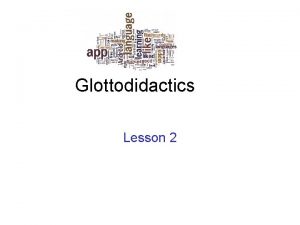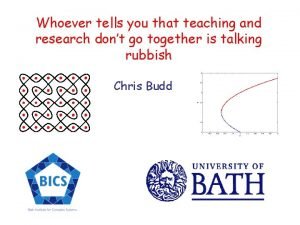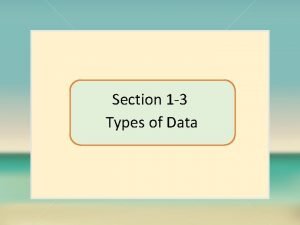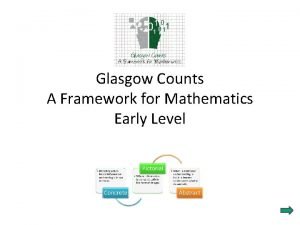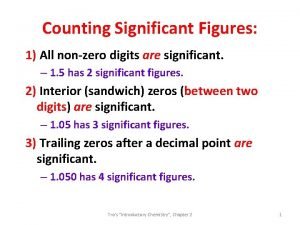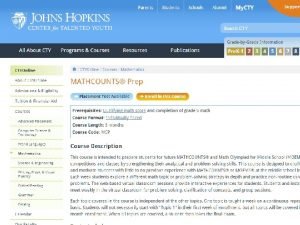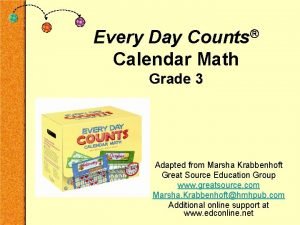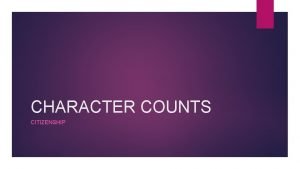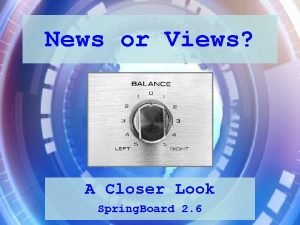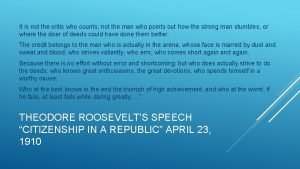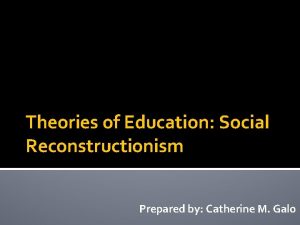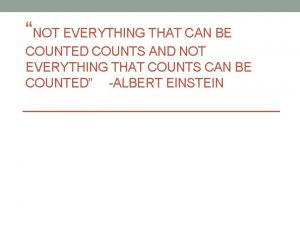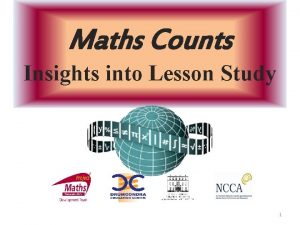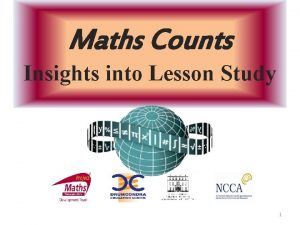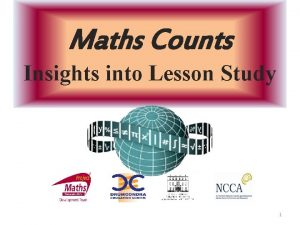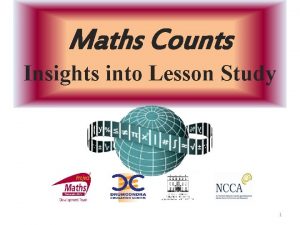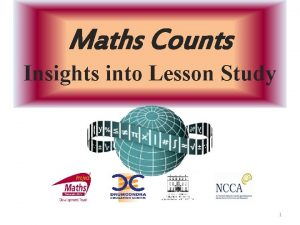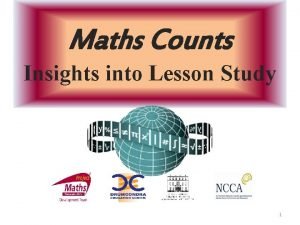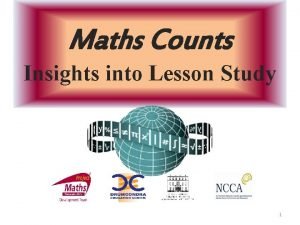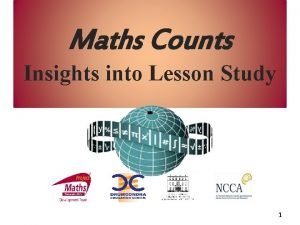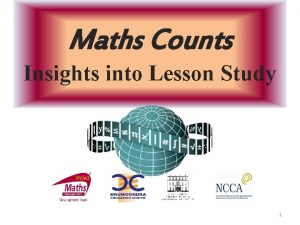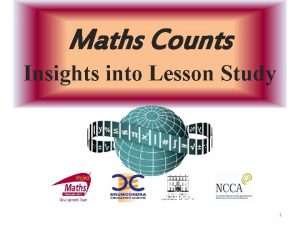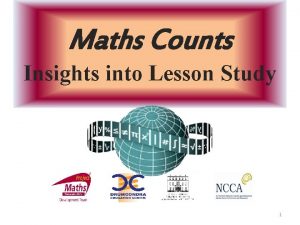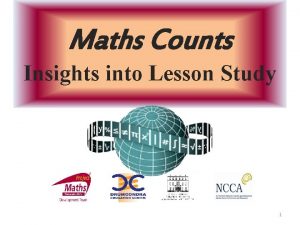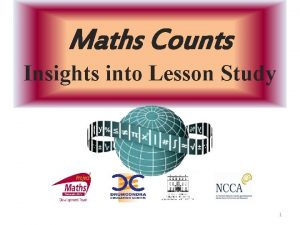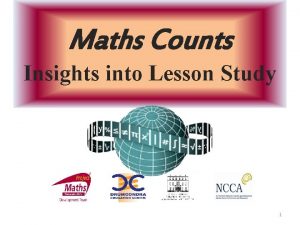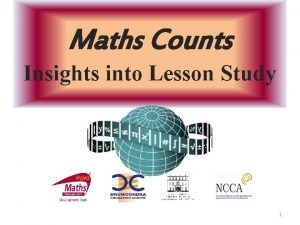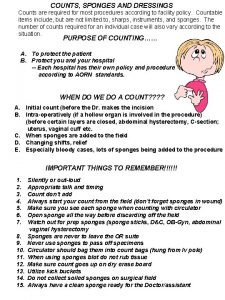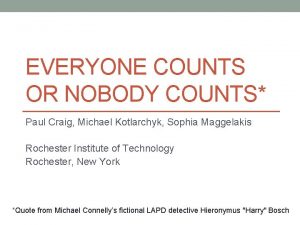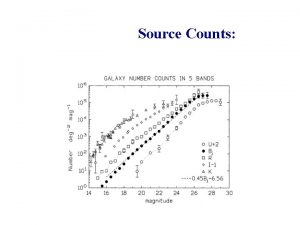Maths Counts Insights into Lesson Study 1 Insights





































- Slides: 37

Maths Counts Insights into Lesson Study 1

Insights into Lesson Study • Introduction: Focus of Lesson • Student Learning : What we learned about students’ understanding based on data collected • Teaching Strategies: What we noticed about our own teaching • Strengths & Weaknesses of adopting the Lesson Study process 2

Introduction Why did we choose to focus on this mathematical area? • We wanted to rethink how we taught integration with an emphasis on conceptual understanding of integration as a process of finding the total (accumulated) change given the rate of change • We wanted students to understand integration as this “summing” process, achieved using area and not just as a set of procedures. • We wanted students from the beginning of the topic to see the use of integration in context. • We chose finding displacement from velocity as the initial context. 3


Introduction Topic investigated: Introducing integration • How we planned the lesson Resources used : • Prior knowledge • Questioning • Multi-representations: Story, table, graph, formula • Board work • Worksheet • Formulae and Tables booklet and • Geo. Gebra 5

Introduction • 6

Introduction • 7

Lesson flow Q. What information can be got from this graph? A. The displacement after any time t. CV 8

Lesson flow Q: What information does this graph give us? Q. What information can be got from this graph? A. The displacement after any time t. Differentiating 9

Use the area of a triangle formula or the trapezoidal rule How do you find the area from 1 -2 s and 2 -3 s? Use the area of a trapezium or subtract the area of two triangles. 10

Split the area into trapezia and use the trapezium rule to find the sum of the areas of the trapezia. This would give an approximate value of the area. 11

Lesson flow: What pattern do you notice? Function for evaluating area AREA The area under the velocity-time graph over an interval of time on the x-axis is the displacement over that interval. Can you make sense of this? 12

Lesson flow: What is integration? 13

Lesson flow: Recovering the rate of change function • How would we recover the displacement function if we only knew the velocity time function? – Not sure • How do you get velocity at an instant from displacement? – We get the derivative of the displacement function. • Can we recover the displacement function from the velocity function? – Reverse the differentiation process 14

Lesson flow: Reverse the differentiation process Function ? Differentiate Derivative What could we call the reverse process? 15

What is the opposite to “social “behaviour? Anti-social behaviour 16

Lesson flow: Reverse the differentiation process Function Antidifferentiate Derivative 17

Lesson flow Differentiating Antidifferentiating -enables us to find area under a curve over an interval The antiderivative gives us an area function 18

Q. What information can be got from this graph? A. The displacement after any time t. 19

The starting value is varying but the rate of change is the same. 20

Anti-differentiate and check your answer Oral work Tables and Formulae booklet 21

Student Learning Data Collected from the Lesson: 1. Academic e. g. samples of students’ work 2. Motivation 3. Social Behaviour 22

Worksheet 23

Student work Correct units: area interpreted in context 24

2 methods of finding area under v(t) curve CV 25

Arrived at by seeing a pattern: 26

Student worksheet (and board) at the end of the class 27

Real life………………. . Speedometers tell us our speed (rate of change of distance) at every instant. We are also interested in how far we have travelled (total change in distance). 28

Common Misconceptions • 29

Units missing 30

Student Learning Issue with units 31

Recommendations The adjustments you have made or would make in the future: • Students using Geo. Gebra to show that the antiderivative of a function is a set of functions. (Geo. Gebra file will be available on the website) 32

Teaching Strategies How did I engage and sustain students’ interest and attention during the lesson? • The lesson followed a “question and answer” format after the initial introduction • Students had activities to do on a regular basis: – – – Drawing graphs Finding area under graphs Pattern recognition Making conclusions Learning new skills and generalising those skills • The teaching strategies improved students’ confidence in their ability to construct new knowledge and this sustained their interest • The full sequence of the lesson being left on the board at the end of the lesson helped students see the big picture 33

Teaching Strategies • Was it difficult to facilitate and sustain communication and collaboration during the lesson? No – students at this level were very motivated to learn and comfortable with asking questions and discussing with their fellow students. 34

Teaching Strategies How did I put closure to the lesson? • I referred to the board work which summarised the lesson. • For homework: Practice of the skill of finding the antiderivative (indefinite integral) from the textbook and verifying answers. 35

Reflections on Lesson Study Process Strengths & Weaknesses As a mathematics team how has Lesson Study impacted on the way we work with other colleagues? • We are planning with common student misconceptions in mind. • We are focussing more on “how to” teach a topic and not just “what to teach” • We are planning with a view to achieving the objectives of the syllabus in tandem: – carry out procedures with understanding, – problem solve, – explain and justify reasoning, – feel confident in being able to do maths and seeing its relevance • We are very aware of making connections to prior and future knowledge, across and within strands, to the real world and if possible to other curricular areas. 36

Reflections on Lesson Study Process Strengths & Weaknesses Personally, how has Lesson Study supported my growth as a teacher? • I have seen the benefits of planning questions as well as worksheets for the introduction of a concept. • I have benefited from increased collaboration with colleagues and from having another teacher observe the learning in my classroom. 37
 Every lesson counts
Every lesson counts Lesson outline lesson 1
Lesson outline lesson 1 What pattern
What pattern Steve ward calm counts
Steve ward calm counts Tdot traffic count
Tdot traffic count Cage questionaire
Cage questionaire It consists of numbers representing counts or measurements.
It consists of numbers representing counts or measurements. Quality counts background checks
Quality counts background checks Cry unit
Cry unit Reading inventory score chart
Reading inventory score chart Bias through statistics and crowd counts examples
Bias through statistics and crowd counts examples Make every opportunity count
Make every opportunity count Make every opportunity count
Make every opportunity count Examples of bias through statistics and crowd counts
Examples of bias through statistics and crowd counts Glasgow counts early years
Glasgow counts early years Sig fig rules
Sig fig rules Mathcounts prep
Mathcounts prep Semcog traffic counts
Semcog traffic counts Everyday calendar math
Everyday calendar math Citizenship character counts
Citizenship character counts Louise skip counts by 4 on a number line
Louise skip counts by 4 on a number line Bias through selection and omission
Bias through selection and omission Trrfcc character counts
Trrfcc character counts Fdot psee
Fdot psee Pdsd reading counts
Pdsd reading counts It isn't the critic who counts
It isn't the critic who counts Every calorie counts
Every calorie counts Summer counts
Summer counts Cordon counts
Cordon counts Define commercial photography
Define commercial photography Theodore brameld contribution to education
Theodore brameld contribution to education Not everything that counts can be counted meaning
Not everything that counts can be counted meaning Ibm resiliency orchestration
Ibm resiliency orchestration Carogra
Carogra Why science is my favourite subject
Why science is my favourite subject Ecological study vs cohort study
Ecological study vs cohort study Retrospective cohort study
Retrospective cohort study Work study and method study
Work study and method study

